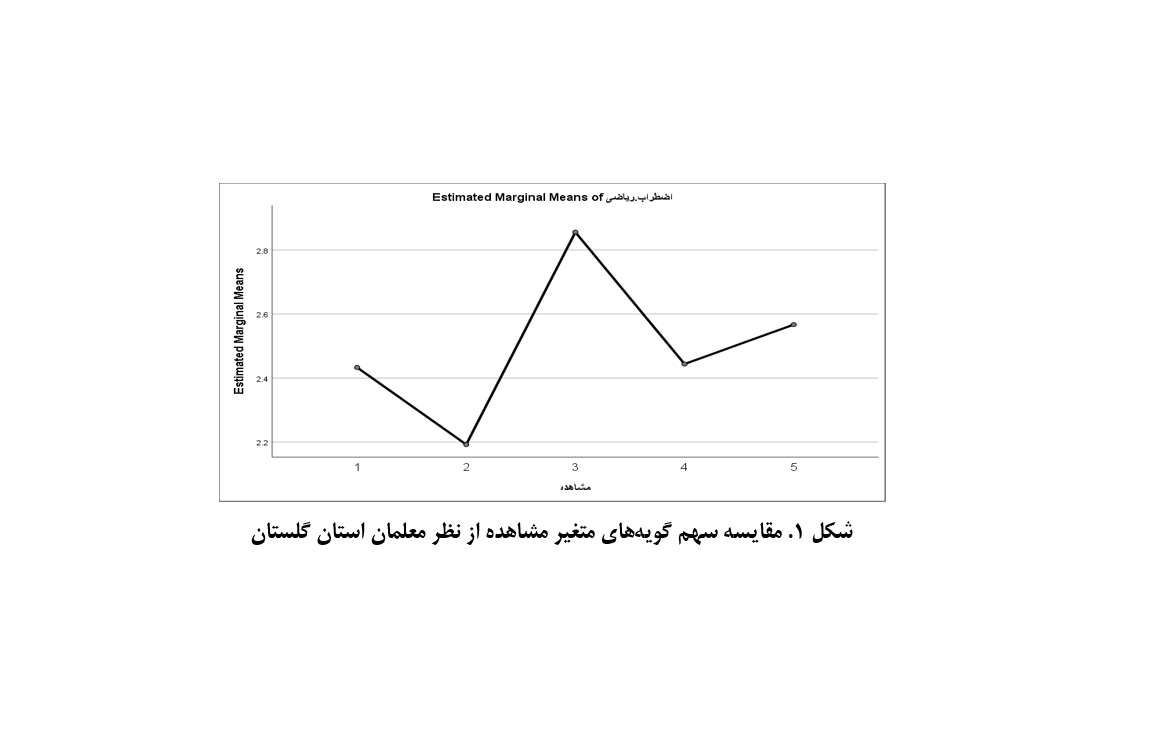سنجش میزان آگاهی معلمان استان گلستان از علائم و علل اضطراب ریاضی در دانشآموزان
کلمات کلیدی:
معلمان, دانشآموزان, اضطراب ریاضی, ابتدایی, متوسطهچکیده
پژوهش حاضر با هدف سنجش میزان آگاهی معلمان استان گلستان از علائم و علل اضطراب ریاضی دانشآموزان انجام شد. این تحقیق، به بررسی میزان تاثیر خودآگاهی معلمان بر میزان شناخت آنان بر علل و عوامل اضطراب ریاضی در دانشآموزان خود و میزان تاثیر متغیرهای جامعهشناختی جنسیت، سابقه تدریس، مدرک تحصیلی، مکان تدریس، وضعیت معلمی و مقطع تدریس آنان بر میزان این آگاهی پرداخته است. روش پژوهش توصیفی از نوع پیمایشی بود. جامعة آماری این تحقیق کلیه معلمان استان گلستان بود که در سال 1403-1402 مشغول به خدمت بودند. از روش خوشهایی، نمونهای به تعداد 187 نفر برای شرکت در پژوهش انتخاب شدند. روایی پرسشنامه با نظر متخصصان حوزة آموزش ریاضی تأیید شد و پایایی آن با ضریب آلفای کرانباخ مربوط به 18 سوال پنج درجهایی پرسشنامه برابر،86/0 و برای 18 سوال چهار درجهایی پرسشنامه برابر 79/0 تعیین گردید. تحلیل دادهها با استفاده از نرمافزار SPSS26 و شاخصهای آمار توصیفی (درصد فراوانی، میانگین و انحرافمعیار) و آمار استنباطی (آزمون تی تکنمونهایی، تی مستقل، همبستگی و تحلیل واریانس با اندازهگیری مکرر) انجام شد. یافتههای پژوهش نشانداد که میزان آگاهی معلمان استان گلستان از علائم و علل اضطراب ریاضی در دانشآموزان با میانگین 85/2 و سطح معناداری 000/0 ، بالاتر از میانگین نظری جامعه (75/2) است. همچنین تفاوت معناداری در میانگین گروههای مربوط به متغیرهای سابقه تدریس، مقطع تدریس و مدرک تحصیلی، به ترتیب با سطح معناداری 049/0، 000/0 و 003/0، مشاهده شد. از نظر معلمان اضطراب ریاضی در کلاسهای درس وجود دارد و اضطراب معلمان نقشی در ایجاد آن در دانشآموزان ندارد و اضطراب ریاضی والدین تاثیر بسزایی بر اضطراب ریاضی فرزندان دارد. همچنین، بین مقیاس"خودادراکی معلمان از اضطراب ریاضی" و مقیاس"پاسخ معلمان به دانش آنان در رابطه با علائم اضطراب در دانشآموزان" رابطه ضعیف اما معناداری وجود دارد (0.03= p، 0.151=r) اما رابطهای بین خودادراکی معلمان با مشاهده آنان از اضطراب ریاضی و پاسخ آنان به علل اضطراب در دانشآموزان یافت نشد.
دانلودها
مراجع
Falco LD, Summers JJ. Social Persuasions in Math and Their Prediction of STEM Course Self-Efficacy in Middle
School. The Journal of Experimental Education. 2021;89(2):326-43. doi: 10.1080/00220973.2019.1681350.
Cresswell C, Speelman CP. Does Mathematics Training Lead to Better Logical Thinking and Reasoning? A CrossSectional Assessment from Students to Professors. PLOS One. 2020;15(7):e0236153. doi: 10.1371/journal.pone.0236153.
Scheibe DA, Was CA, Dunlosky J, Thompson CA. Metacognitive Cues, Working Memory, and Math Anxiety: The
Regulated Attention in Mathematical Problem Solving (RAMPS) Framework. Journal of Intelligence. 2023;11(6):117. doi:
3390/jintelligence11060117.
Fennema E, Sherman JA. Fennema-Sherman Mathematics Attitudes Scales: Instruments Designed to Measure
Attitudes Toward the Learning of Mathematics by Females and Males. Journal for Research in Mathematics Education.
;7(5):324-6. doi: 10.5951/jresematheduc.7.5.0324.
Manapa I. Mathematics Anxiety Level of Pre-Service Elementary School Teachers During Online Learning in the
COVID-19 Pandemic. Journal of Mathematics Education (Medives). 2021;5:339-52. doi: 10.31331/medivesveteran.v5i2.1720.
Copur-Gencturk Y, Thacker I, Cimpian JR. Teachers' Race and Gender Biases and the Moderating Effects of Their
Beliefs and Dispositions. International Journal of STEM Education. 2023;10(1):31.
Escalera-Chávez M, Moreno-García E, García-Santillán A, Córdova-Rangel A. Factors that Promote the Level of
Anxiety Towards Mathematics in Upper Middle-Level Students in the Rioverde San Luis Potosí Region. European Journal of
Education Studies. 2016;2:8-22.
Pekrun R. The Control-Value Theory of Achievement Emotions: Assumptions, Corollaries, and Implications for
Educational Research and Practice. Educational Psychology Review. 2006;18:315-41. doi: 10.1007/s10648-006-9029-9.
BaoGuo AN, KahHeng CH. Emotional Status of Malaysian Teachers on Online Teaching During the COVID-19
Pandemic. Turkish Journal of Computer and Mathematics Education (TURCOMAT). 2021;12(14):5104-14.
Huyen L, Ngo T, Nguyen T, Thanh T, Bao T, Vinh LT. An Investigation of Mathematics Anxiety and Academic
Coping Strategies Among High School Students in Vietnam: A Cross-Sectional Study. Frontiers in Education. 2021;6:742130.
Jafari F, Mousavi F, Emamipour S. The Role of Perfectionism and Achievement Goals in Predicting Test Anxiety
Among First-Year Female Middle School Students. Educational and Learning Research. 2015;12(2):65-78.
Sasanguie D, Larmuseau C, Depaepe F, Jansen BR. Anxiety About Mathematics and Reading in Preadolescents Is
Domain-Specific. Journal of Intelligence. 2024;12(2):14. doi: 10.3390/jintelligence12020014.
Hosseini M, Tehranian A, Behzadi MH, Alem al-Hoda SH. Examining the Relationship Between Teachers' Skills in
Qualitative Evaluation of Mathematics, Math Anxiety, Academic Procrastination, and Students' Thinking Styles. Mashhad
University of Medical Sciences Journal. 2022;65(2):870-84.
Willis R, Lynch D, Peddell L, Zehntner C, Bruck P. Get on the Cycle of Engagement with Mathematics: Re-imagining
a Model and a Three-Step Process for Primary/Secondary Teachers. Re-imagining Teaching Improvement: From Early
Childhood to University2024. p. 131-901.
Su X, Guo Z. An Analysis of the Effect of Teachers' Behavior on Mathematics Anxiety and the Role of Intervention
Programs. 2022.
Szczygieł M. More Evidence That Math Anxiety Is Specific to Math in Young Children: The Correlates of the Math
Anxiety Questionnaire for Children (MAQC). International Electronic Journal of Elementary Education. 2020;12(5):429-38.
doi: 10.26822/iejee.2020562133.
Polacco D, Luliana M, Dekel R. Perspectives of Teachers on the Signs and Causes of Mathematics Anxiety. Acta
Didactica Napocensia. 2023;16(2):126-43.
Hembree R. The Nature, Effects, and Relief of Mathematics Anxiety. Journal for Research in Mathematics Education.
;21(1):33-46. doi: 10.5951/jresematheduc.21.1.0033.
Ayuso N, Fillola E, Masiá B, Murillo AC, Trillo-Lado R, Baldassarri S, et al. Gender Gap in STEM: A Cross-Sectional
Study of Primary School Students' Self-Perception and Test Anxiety in Mathematics. IEEE Transactions on Education.
;64(1):40-9. doi: 10.1109/TE.2020.3004075.

دانلود
چاپ شده
ارسال
بازنگری
پذیرش
شماره
نوع مقاله
مجوز
حق نشر 2024 نشریه پژوهش و نوآوری در تربیت و توسعه

این پروژه تحت مجوز بین المللی Creative Commons Attribution-NonCommercial 4.0 می باشد.










